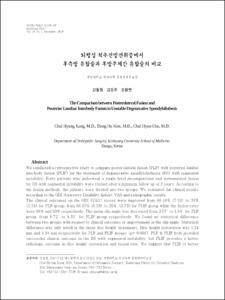퇴행성 척추전방전위증에서 후측방 유합술과 후방추체간 유합술의 비교
- Keimyung Author(s)
- Kang, Chul Hyung; Cho, Chul Hyun
- Department
- Dept. of Orthopedic Surgery (정형외과학)
- Journal Title
- Keimyung Medical Journal
- Issued Date
- 2010
- Volume
- 29
- Issue
- 2
- Keyword
- Degenerative spondylolisthesis; Lumbar; Posterior lumbar interbody fusion; Posterolateral fusion; Segmental instability
- Abstract
- We conducted a retrospective study to compare posterolateral fusion (PLF) with posterior lumbar
interbody fusion (PLIF) for the treatment of degenerative spondylolisthesis (DS) with segmental
instability. Forty patients who underwent a single level decompression and instrumented fusion for DS with segmental instability were studied after a minimum follow up of 2 years. According to the fusion methods, the patients were divided into two groups. We evaluated the clinical results according to the ODI (Oswestry Disability Index), VAS and radiographic results. The clinical outcomes on the ODI (VAS) scores were improved from 66.48% (7.52) to 38% (2.24) for PLF group, from 68.07% (8.53) to 35%, (3.73) for PLIF group while the fusion rates were 88% and 93% respectively. The mean slip angle was decreased from 3.57°to 1.84°for PLF group, from 6.72°to 4.35°for PLIF group respectively. We found no statistical difference between two groups with respect to clinical outcomes or improvement in the slip angle. Statistical difference was only noted in the mean disc height increments. Disc height restoration was 1.24 mm and 4.04 mm respectively for PLF and PLIF groups (p= 0.001). PLF & PLIF both provided successful clinical outcome in the DS with segmental instability, but PLIF provides a better
radiologic outcome in disc height restoration and fusion rate. We suggest that PLIF is better surgical option in the treatment of DS with segmental instability.
- Alternative Title
- The Comparison between Posterolateral Fusion and
Posterior Lumbar Interbody Fusion in Unstable Degenerative Spondylolisthesis
- Publisher
- Keimyung University School of Medicine
- Citation
- 강철형 et al. (2010). 퇴행성 척추전방전위증에서 후측방 유합술과 후방추체간 유합술의 비교. Keimyung Medical Journal, 29(2), 102–109.
- Type
- Article
- Appears in Collections:
- 2. Keimyung Medical Journal (계명의대 학술지) > 2010
1. School of Medicine (의과대학) > Dept. of Orthopedic Surgery (정형외과학)
- 파일 목록
-
-
Download
 29-102.pdf
기타 데이터 / 356.81 kB / Adobe PDF
29-102.pdf
기타 데이터 / 356.81 kB / Adobe PDF
-
Items in Repository are protected by copyright, with all rights reserved, unless otherwise indicated.